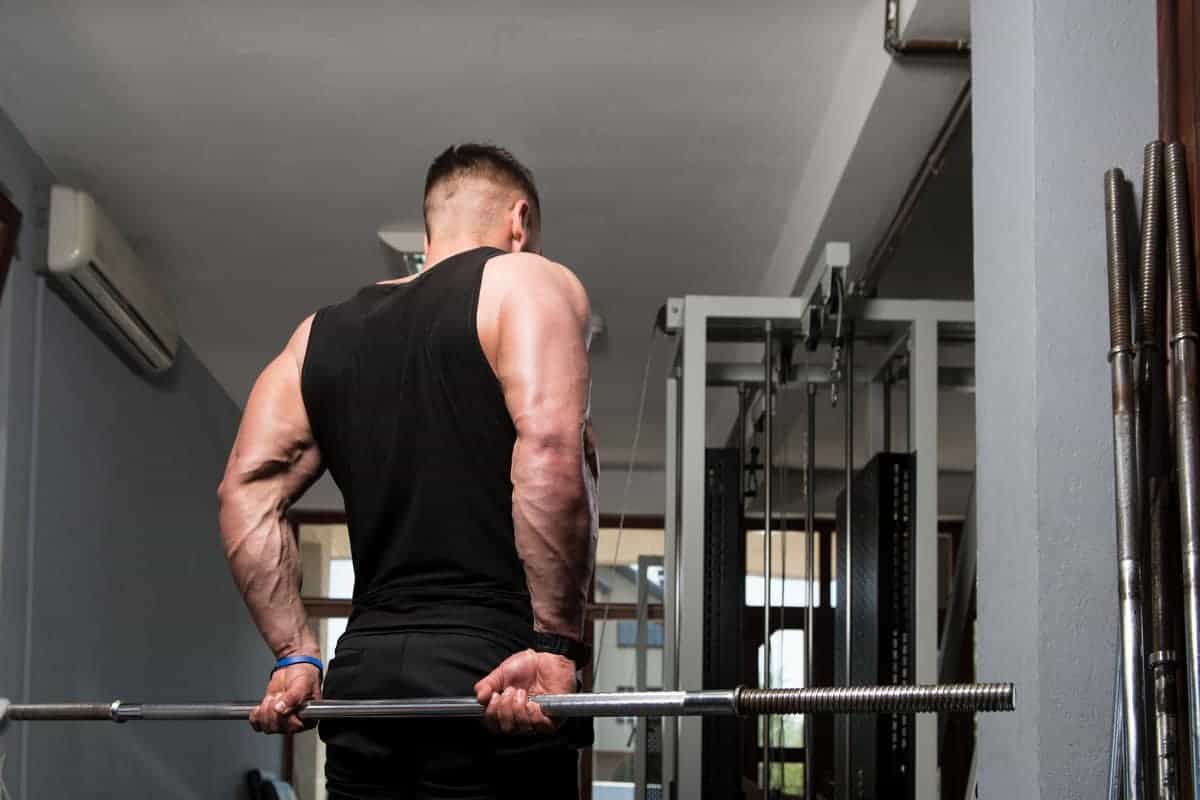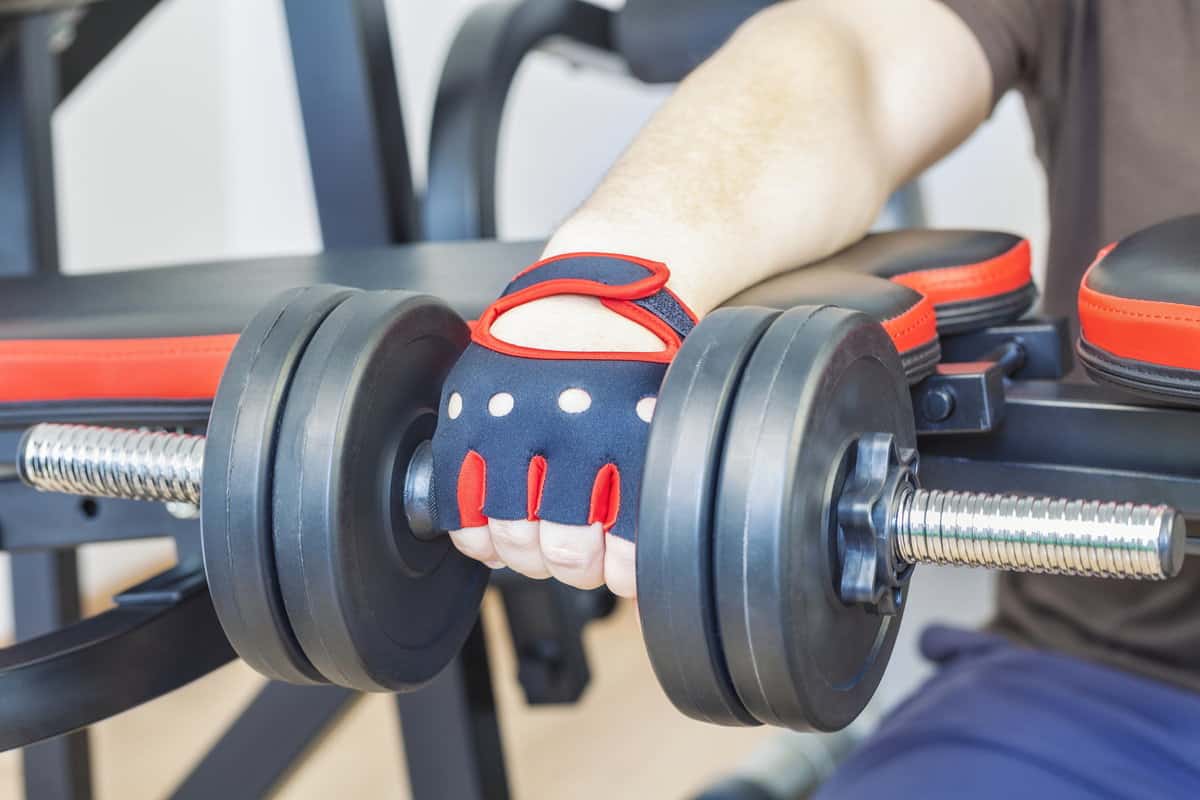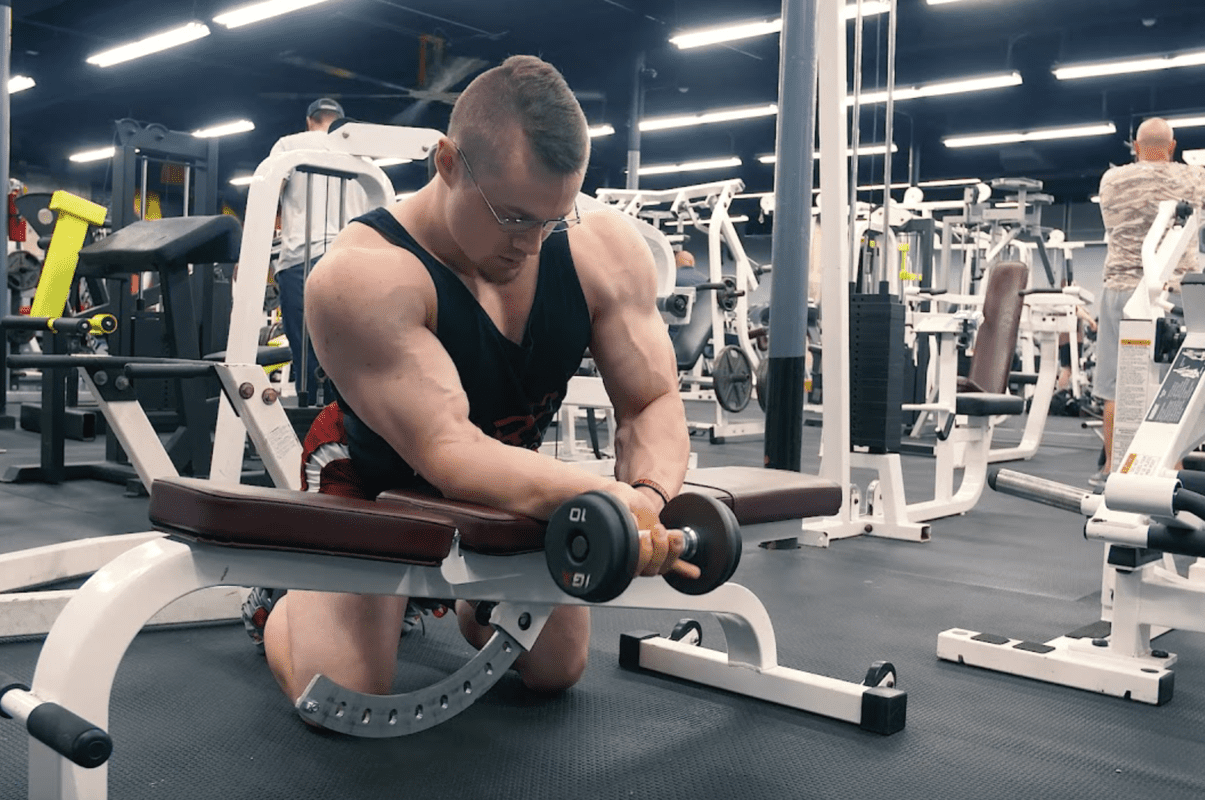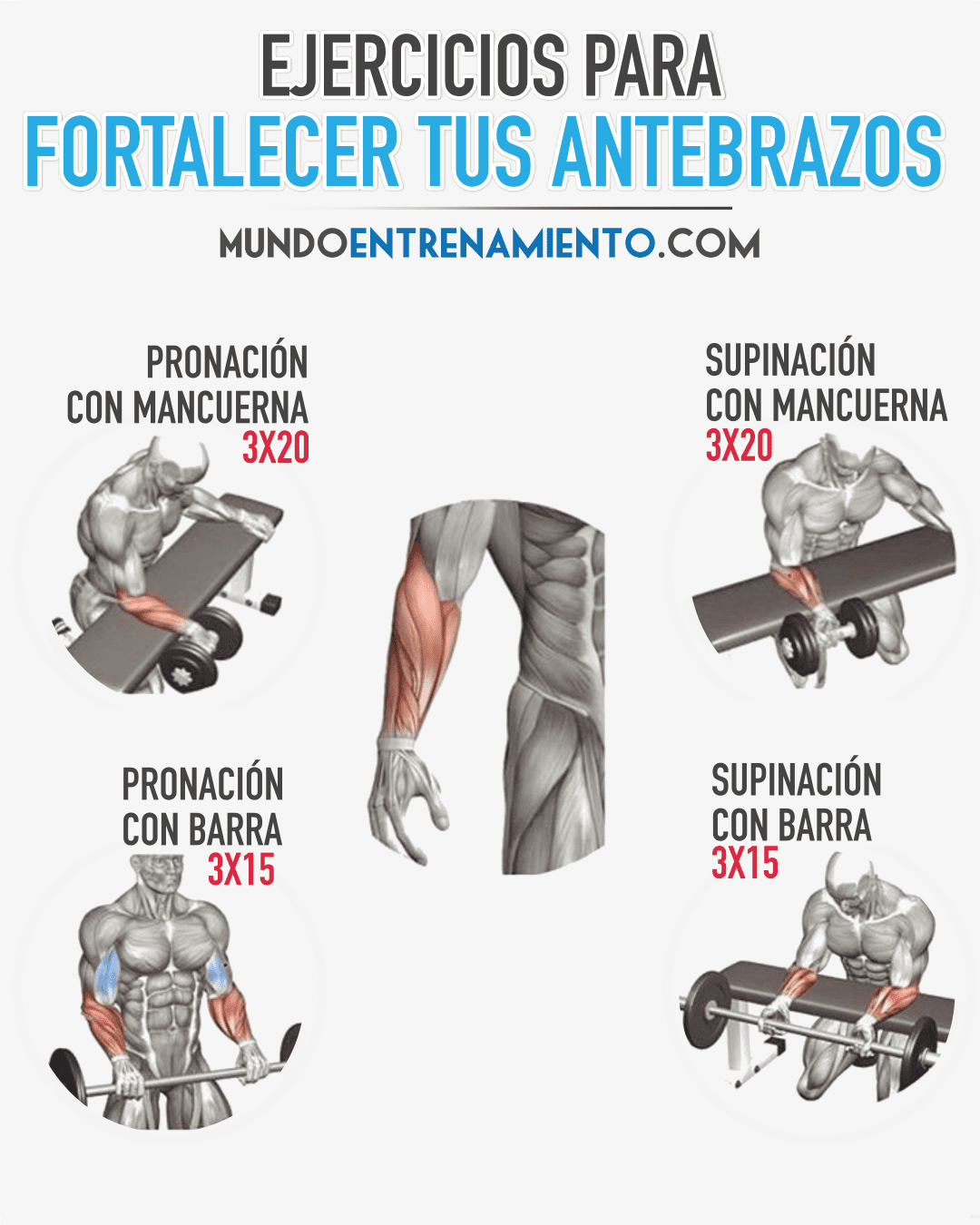In this article, we will make a brief anatomical review of the forearm, its movements, and the best forearm exercises you can perform for strengthening.
The grip strength is a great indicator for competitive sports contexts and sports for all or health-sport. The health of the general population is associated with grip strength, measured by dynamometry, and exercised with forearm exercises.
Low figures in dynamometry are associated with metabolic syndrome, malnutrition, osteoporosis, and/or kidney failure, among others (9). With forearm exercises, we improve the performance of other strength exercises, which allows us to prevent these pathologies.
Forearm exercises, both strength and stretching, allow us to have a wide range of practical tools to train manual grip strength.
Why is it important to perform forearm exercises?
The forearms are an important part of the human body, as they are responsible for fine and precise movements in the hands and fingers.
Additionally, strengthening them and performing forearm exercises can also help improve overall health and reduce mortality. Studies have shown that greater muscle strength is associated with a longer life expectancy and a lower risk of chronic diseases such as diabetes and obesity (19,3)
Regarding functions, performing forearm exercises can improve the ability to perform daily tasks, such as opening doors or lifting heavy objects, and can also improve endurance in sports and activities that require a lot of grip or holding (11,16). Additionally, strengthening the forearms can help prevent injuries and pain in the wrist and elbow. (10,1)
Performing forearm exercises is important to improve physical appearance, overall health, improve the ability to perform daily tasks, and prevent injuries. It is important to include specific forearm exercises in your training routine to obtain these benefits.
Anatomy of the forearms
The forearms are the part of the human body located between the shoulder bones and the wrist bones. They are composed of two main bones: the radius and the ulna.
The radius is the bone located on the outer part of the forearm and is the longest bone. The ulna is the bone located on the inner part of the forearm and is shorter than the radius.
There are other ways to classify these forearm muscle groups that divide them according to their functions:
- Forearm extensors (17): movement that moves the hand away from the body. Among them are: Brachioradialis, long radial extensor of the carpus, short radial extensor of the carpus, supinator, etc.
- Forearm flexors: movement that brings the hand closer to the body. Among them are: Pronator teres, radial flexor of the carpus, ulnar flexor of the carpus, palmaris longus, and superficial flexor of the fingers.
- The forearm supinators/pronators are the muscles that help rotate the hand upwards (supination) and downwards (pronation). Among the most important supinator/pronator muscles of the forearm are the long supinator, the pronator teres, and the pronator quadratus.
After this brief theoretical description, let’s move on to see the different types of exercises we can incorporate into our training routine to make them grow.
What are the forearm muscles?
It is very important to know the musculature of the upper static chain (4) to know what we are working on with forearm exercises.
- Musculature that mobilizes the elbow: long supinator, anterior brachial, biceps brachii, triceps brachii, anconeus, pronator quadratus, pronator teres, and short supinator.
- Musculature that mobilizes the wrist:
- Flexors: major palmar, minor palmar, and anterior ulnar.
- Extensors: first radial or long radial extensor, second radial or short radial extensor, and posterior ulnar.
- Accessories: long common superficial flexor of the fingers, long common flexor of the fingers, and common extensor of the fingers.
- Musculature that mobilizes the hand:
- Antebrachials: common superficial flexor of the fingers, common deep flexor of the fingers, common extensor of the fingers, extensor of the index finger, extensor of the little finger.
- Palmar of the middle area of the hand (interosseous): dorsal interosseous and ventral interosseous.
- Lumbricals (of the hypothenar eminence): abductor of the little finger, short flexor of the little finger, and opponent of the little finger.
- Of the thenar eminence: adductor of the thumb, opponent of the thumb, short flexor of the thumb, and short abductor of the thumb.
- Antebrachials specific to the thumb: long flexor of the thumb, long abductor of the thumb, long extensor of the thumb, and short extensor of the thumb.
Forearm exercises you need to know
We present a list of the main forearm exercises, not meaning that you should include all these forearm exercises; rather, as with any muscle group, you should make a good selection of exercises and adjust the training variables based on your context and needs.
Reverse barbell curl
You should select a loaded bar, use a pronated grip. With your elbows close to your body, and with the bar close to your torso, flex your elbow until the forearms are vertical.
In summary, it’s like doing a bicep curl but with a pronated grip. You can also use a Z bar or a pulley.
In this study (14), the reverse curl is compared to the barbell bicep curl, measuring the greater or lesser involvement of the forearm muscles. The result was a greater incidence of the forearm muscles in the first exercise.
Reverse preacher curl with barbell
Sit on the preacher bench, placing the back of your arms on the pad. Hold the curl bar with an overhand grip shoulder-width apart.
In these forearm exercises, you should lift the bar until the forearms are vertical. Lower the bar until the arm is fully extended. Repeat.
Rolling barbell twist
Stand in front of a barbell placed on its rack or holding a short bar with the rope or band attached, hold with the hand that will start the movement with as much of the palm of the hand as possible, aiming for the knuckles to point almost to the ground.
From here, begin to extend the wrist in a controlled manner, feeling the contraction backward, aiming for your knuckles to point towards you as much as possible. Hold the contraction briefly and continue with the gesture until completing the set repetitions (15).
Wrist extension with barbell on bench
In these forearm exercises, you should sit and grab the bar with a narrow pronated grip shoulder-width apart. Rest the forearms on the bench with the wrists slightly beyond the knees. Lift the bar pointing the knuckles upwards as high as possible. Return until the knuckles point downwards as much as possible. Repeat.
It is an exercise that has been shown to enable strength gain, hypertrophy, and flexibility in the forearms.
As variations, you can introduce the same exercise but with a dumbbell or, on the other hand, you can rest the forearms on your legs instead of on a bench.
Wrist curl with barbell on bench
In this type of forearm exercise, you should sit and grab the bar with a narrow supinated grip shoulder-width apart. Rest the forearms on the bench with the wrists slightly beyond the knees. Lift the bar pointing the knuckles upwards as high as possible. Return until the knuckles point downwards as much as possible. Repeat.
As can be seen, it is very similar to the exercise described above, but with a supine grip to emphasize different muscles within the forearm.
Kettlebell wrist turns
Kneel on the floor or in front of a bench, laying a kettlebell on one of its sides. Then, keeping the elbow supported and flexed, hold the handle with the palm of your hand facing the ceiling.
Start the movement by bending the hand to the opposite side, think of bringing the palm of the hand towards the floor, as if you wanted to arm wrestle the kettlebell.
Once you manage to lay it to the other side, perform the same movement but the opposite, returning it to the initial position, resisting the eccentric phase (15).
Lying pronation with dumbbells (arm up)
Lie on a bench or mat. With the hand of the upper arm, grab the unilaterally loaded dumbbell; pinky placed near the weighted side.
[article ids=”75385″] In these forearm exercises, you should bend the elbow approximately 90 degrees and place the arm on the hip or side of the waist. Place the thumb up (in supination). Rotate the dumbbell so that the thumb rotates down (pronation). Return and repeat.
As complementary work, we could use fat grip in bicep exercises or pull-ups. Fat Grips are cylindrical accessories added to the training bar to increase its diameter.
Several studies have confirmed their usefulness for improving grip strength and activation of forearm muscle groups (18,8). On the other hand, the exercises mentioned in this article to exercise the biceps, can also serve as complementary work for our forearms.
What exercises work the forearms?
Wrist flexors and extensors (23)(24)(25):
- Dorsal wrist extension or forearm curl in pronation (barbell, dumbbells, or machine):
- Initial position: in a seated position, you should rest the forearms on the thighs (or alternatively, on a bench), and grab the grip of the external weight (barbell, dumbbell, or the specific machine grip), with the hands in pronation, and in passive flexion.
- Execution: perform a wrist extension (the palms point backward in the initial position, and we try to point the palms forward in the final position).
- This is a very suitable exercise to strengthen the wrist joint, which is usually one of the weakest links in the upper static muscle chain.
- It would be quite advisable not to use high loads that prevent us from raising the hands above the wrist height. The principle of movement amplitude prevails.
- This exercise involves the musculature of the first and second radial, the common extensor of the fingers of the hand, the extensor of the little finger, and the anterior ulnar.
- Palmar wrist flexion or forearm curl in supination (barbell, dumbbells, or machine):
- Initial position: in a seated position, we will have to rest the forearms on the thighs (or alternatively, on a bench), and grab the grip of the external weight (barbell, dumbbells, or the specific machine grip), with the hands in supination, and in passive extension.
- Execution: perform the wrist flexion (the palms point forward in the initial position of the exercise, and should end up pointing towards our own body).
- In the palmar flexion exercise, it would not be appropriate to let the bar reach the fingertips.
- This movement, with resistance to overcome, involves the major palmar, minor palmar, anterior ulnar, deep flexors of the fingers, and superficial flexors of the same (the flexors of the fingers constitute a large part of the total volume of wrist flexors).
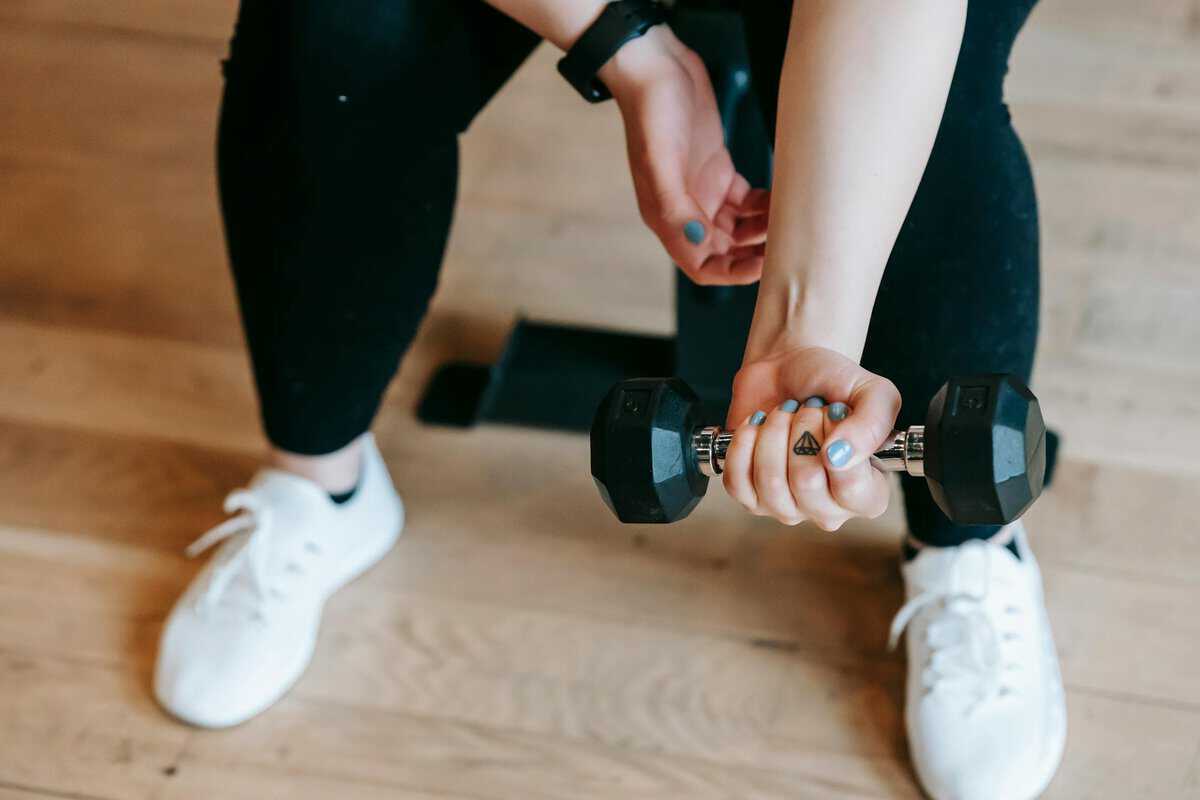
- Forearm exercises with kettlebells (22):
- Initial position: place the kettlebell in front of us. We can position ourselves in a seated position and the kettlebell on a plyometric box, or place the kettlebell on the floor and get into a quadruped position. The ball of the kettlebell should be in the farthest position from us, and the handle pointing towards us (the grip should be at half-arm from our torso). We grab the kettlebell by the horns, with a bilateral hammer grip, and with the ball resting on a uniform surface.
- Execution: the kettlebell will change position, starting at rest on the floor and at the end of the exercise, with the ball on top of our hands. We should not lift from the floor (or plyometric box) the forearms, hands, or the handle of the kettlebell.
- Kettlebell fixation:
- Initial position: place the kettlebell in front of us. We can position ourselves in a seated position and the kettlebell on a plyometric box, or place the kettlebell on the floor and get into a quadruped position. The ball of the kettlebell should be in the farthest position from us, the grip vertical, and at half-arm from our body. We will grab the kettlebell by the upper corner, with a unilateral hammer grip.
- Execution: the kettlebell goes from having the ball resting on the floor to being placed (the ball) on top of the grip, in a balanced position and held by one hand, preventing the kettlebell from falling to one of the two sides of the hand.
How many forearm sets should I do?
Although some authors talk about the number of sets and repetitions, the most appropriate would be to quantify forearm exercises considering the sets, the repetitions, and the load (Schoenfeld, B; 2017).
Despite the contribution of the referenced author, we would have to consider the effort sensation in forearm exercises, as there is a strong correlation between the subjective sensation of effort (Borg scale), blood lactate, and heart rate.
Authors like Wernborn et al (2007), found that the cross-sectional area of the upper body segments, modified (upwards) as follows (26):
- 0.15% with 38 repetitions per session in 7 days.
- 0.26% with 42-66 repetitions per session in 7 days.
- 0.18% with 74-120 repetitions per session in 7 days.
An inverted U-shaped curve (10) is observed in the graph that correlates volume with hypertrophy. The relationship between hypertrophy and training volume has a peak of muscle accretion with a medium training volume, with a downward growth if that amount of exercise is exceeded (in the case of the previous research, the appropriate volume would be 42-66 repetitions per session), both in general strength exercises and forearm exercises.
How long should I rest between forearm sets?
The time period between one set and another of forearm exercises, can be referred to as interval or rest period, or even rest period (active or inactive).
We can understand that there are three types of inactive rest periods, all determined by their duration. We find short rests (thirty seconds or less), moderate rests (from sixty to ninety seconds), and long rests (more than three minutes) (10).
It is generally understood that moderate rest intervals produce greater increases in blood lactate concentration and reduce blood pH more, compared to longer rest periods (7). It is estimated to be the ideal situation for hypertrophic stimulation.
How often should you train the forearm?
The training frequency should be defined as the number of physical exercise sessions performed in a given time range (for example, a week).
Manipulating the training frequency seems to be an appropriate strategy to optimize muscle hypertrophy gains, as modifying the frequency involves manipulating the training volume variable.
Since physical exercise routines that use full-body training per session result in greater short-term gains in terms of hypertrophy, we can alternate full-body training with split routines to optimize hypertrophy gains in the medium-long term (split training routines allow more training volume per muscle group and session)(10).
What forearm exercises stretch the forearms?
The sports that benefit from forearm stretching exercises are (21): basketball, volleyball, racket sports, athletics throws, canoeing, rowing,…; and the injuries in which these types of stretches can be useful are: tennis elbow, pitcher’s elbow, golfer’s elbow, wrist tendinitis, carpal tunnel syndrome,…
If we search thoroughly in the scientific-technical bibliography related to sports, and more specifically in the stretching exercise encyclopedias, we can find specific forearm exercises to stretch the musculature of the area, that is, the musculature surrounding the wrists and fingers, such as (20)(21).
These stretches are ideal after forearm exercises:
- Exercise 1:
- We will press the palms of the hands against the wall while the fingers point downwards.
- We start with the elbows extended, and to progress in the elongation of the finger flexors, we will gradually flex the elbows, bringing the body closer to the wall.
- Exercise 2:
- We will position ourselves in a quadruped position, with the elbows extended and the hands resting on the floor, pointing the fingers towards the knees.
- To increase the elongation of the finger and wrist flexors, we move the torso backward.
- Exercise 3:
- We will extend the elbow with the wrist in external rotation (the palm goes backward and then rotates outward).
- Exercise 4:
- With the stretching arm’s elbow extended, we will externally rotate the wrist, using the other hand to increase the elongation of the wrist and finger extensors.
- Exercise 5:
- We will interlace the fingers, with the hands at shoulder height, and stretch the elbows, rotating the hands and putting the hands outward.
- The distal area of the arms (understood as forearms, wrists, and fingers) comprises many muscles, ligaments, and tendons (in addition to other passive joint elements).
- We should not overstretch the area by stretching too forcefully or too quickly.

- Exercise 6:
- To stretch the fingers, we will bring the fingertips together and press the hands against each other.
- The forearm, wrist, and finger area should not be overstretched, as it is an area where we must ensure a good level of strength. There should be an adequate balance between forearm strength and stretching exercises.
Is it enough to train with multi-joint exercises if I want to develop the forearms?
This is a very common question, not only in relation to forearm training but also concerning many muscle groups: quadriceps, biceps, triceps…
The answer is that it depends. Several studies have shown strength gains without performing forearm exercises. A study published by De Franca, H.S. et al in 2011 (5) compared the effects of two training programs in terms of hypertrophy.
Participants performed multi-joint exercises or direct work exercises for the torso, and the results showed that both groups experienced similar gains in terms of quadriceps hypertrophy.
Another study published in 2010 (7) investigated the effects of different training programs in terms of quadriceps hypertrophy.
Participants performed multi-joint exercises or direct work exercises for the quadriceps, and the results showed that the group that performed multi-joint exercises experienced greater gains in terms of quadriceps hypertrophy compared to the group that performed direct work exercises.
While this literature is somewhat confusing, as depending on the muscle group and the study itself, we can find one conclusion or another.
Just as in other observations, it has been found that the fact that a muscle is activated in an exercise does not necessarily mean that hypertrophy will occur (12), but rather that the stimulus for that specific muscle must be sufficient, and the necessary conditions must be met for that muscle mass gain to occur (2).
On the other hand, we can also find differences in the results in the current scientific literature depending on whether we are dealing with beginner or advanced subjects.
In the case that we only wanted to make them grow with compound exercises, such as a pull-up, we could leave many of the functions performed by the forearm untrained, such as active supination or pronation.
Although the forearm muscles are activated during a pull-up (6), this activation in some subjects and conditions may not be the ideal context for hypertrophy to occur in them.
Conclusion
The strength of the forearm and hand region represents a differential aspect in training, being a limiting factor in many exercises, such as all those that include the upper body (such as forearm exercises): conventional (bars, dumbbells, machines, pulleys) and non-conventional (kettlebells, clubbells, macebell).
Performing forearm exercises should be a priority if you have a sport that requires great grip strength, if you want to prevent wrist and elbow injuries, as well as if you want to have an aesthetic and balanced physique. The forearm muscles are divided into flexors, extensors, and pronators/supinators.
You can use these forearm exercises to cover their functions: lying pronation with dumbbells (arm up), wrist curl with barbell on bench, kettlebell wrist turns, wrist extension with barbell on bench, rolling barbell twist.
Finally, according to biomechanics and current scientific evidence, it seems necessary to introduce direct work and perform forearm exercises for the best strength and muscle mass increase.
Bibliographic references
- Avery, D.M., Rodner, C.M. & Edgar, C.M. Sports-related wrist and hand injuries: a review. J Orthop Surg Res 11, 99 (2016)
- Baz-Valle, E., Fontes-Villalba, M., & Santos-Concejero, J. (2021). Total Number of Sets as a Training Volume Quantification Method for Muscle Hypertrophy: A Systematic Review. forearm exercises Journal of strength and conditioning research , 35 (3), 870–878.
- Boonpor, J., Parra-Soto, S., Petermann-Rocha, F., Ferrari, G., Welsh, P., Pell, J. P., Sattar, N., Gill, J. M. R., Ho, F. K., Gray, S. R., & Celis-Morales, C. (2021). Associations between grip strength and incident type 2 diabetes: findings from the UK Biobank prospective cohort study. BMJ open diabetes research & care , 9 (1), e001865.
- Calais-Germain, B. (1999). Anatomy for movement. Vol I. Spain: La liebre de marzo.
- De França, H. S., Branco, P. A., Guedes Junior, D. P., Gentil, P., Steele, J., & Teixeira, C. V. (2015). The effects of adding single-joint exercises to a multi-joint exercise resistance training program on upper body muscle strength and size in trained men. Applied physiology, nutrition, and metabolism = forearm exercises Physiologie appliquee, nutrition et metabolisme , 40 (8), 822–826.
- Dickie, J. A., Faulkner, J. A., Barnes, M. J., & Lark, S. D. (2017). Electromyographic analysis of muscle activation during pull-up variations. Journal of electromyography and kinesiology : forearm exercises official journal of the International Society of Electrophysiological Kinesiology , 32, 30–36
- Evan, E. S., Coburn, J. W., Brown, L. E., Judelson, D. A., Khamoui, A. V., Tran, T. T., & Uribe, B. P. (2010). A comparison of muscle activation between a Smith machine and free weight bench press. Journal of strength and conditioning research, 24(3), 779–784. https://doi.org/10.1519/JSC.0b013e3181cc2237
- Gentil, P., Fisher, J. & Steele, J. A Review of the Acute Effects and Long-Term Adaptations of Single- and Multi-Joint Exercises during Resistance Training. Sports Med 47 , 843–855 (2017).
- Gilroy, A. M., MacPherson, B. R., Ross, L. M., Schünke, M., Schulte, E., Schumacher, U. & Wesker, K. (2009). Prometheus: Atlas of anatomy. Editorial Médica Panamericana.
- Hoogvliet, P., Randsdorp, M. S., Dingemanse, R., Koes, B. W., & Huisstede, B. M. (2013). forearm exercises. Does effectiveness of exercise therapy and mobilisation techniques offer guidance for the treatment of lateral and medial epicondylitis? A systematic review. British journal of sports medicine , 47 (17), 1112–1119
- Hughes, S. S., Lyons, B. C., & Mayo, J. J. (2004). Effect of grip strength and grip strengthening exercises on instantaneous bat velocity of collegiate baseball players. Journal of strength and conditioning research , 18(2), 298–301.
- Leal, L. (2020). FUNDAMENTALS OF EXERCISE MECHANICS: forearm exercises Biomechanics applied to Strength training (1st ed.). Independently published.
- Mannarino, P., Matta, T., Lima, J., Simão, R., & Freitas de Salles, B. (2021). Single-Joint Exercise Results in Higher Hypertrophy of Elbow Flexors Than Multijoint Exercise. Journal of strength and conditioning research , 35 (10), 2677–2681.
- Marcolin, G., Panizzolo, F. A., Petrone, N., Moro, T., Grigoletto, D., Piccolo, D., & Paoli, A. (2018). Differences in electromyographic activity of biceps brachii and brachioradialis while performing three variants of curl. PeerJ , 6, e5165.
- Martinez, S. (2021). Guide to Exercises for Hypertrophy (1st ed., pp. 207–217). Retrieved from https://transactions.sendowl.com/
- Schweizer, Andreas & Furrer, M.. (2007). Correlation of forearm strength and sport climbing performance. Isokinetics and Exercise Science. 15. 211-216. 10.3233/IES-2007-0275.
- Tortora, G. J., & Derrickson, B. (2021). Principles of Anatomy and Physiology forearm exercises (Spanish Edition) (15th ed.). Editorial Médica Panamericana S.A.
- Krings, B. M., Shepherd, B. D., Swain, J. C., Turner, A. J., Chander, H., Waldman, H. S., McAllister, M. J., Knight, A. C., & Smith, J. W. (2021). Impact of Fat Grip Attachments on Muscular Strength and Neuromuscular Activation During Resistance Exercise. Journal of strength and conditioning research , 35 (Suppl 1), S152–S157. https://doi.org/10.1519/JSC.0000000000002954
- Wu, Y., Wang, W., Liu, T., & Zhang, D. (2017). Association of Grip Strength With Risk of All-Cause Mortality, Cardiovascular Diseases, and Cancer in Community-Dwelling Populations: A Meta-analysis of Prospective Cohort Studies. Journal of the American Medical Directors Association , 18 (6), 551.e17–551.e35. forearm exercises https://doi.org/10.1016/j.jamda.2017.03.011
- Blum, B (2000). Stretching. Editorial Hispano Europea.
- Walker, B (2009). Anatomy and stretching. Editorial Paidotribo
- Milo, J (2023). Notes from the course “Kettlebell Training Level 1”. Unedited.
- Cos Morera, F and Irurtia Amigó, A (2011) Terminology of strength exercises with overload (II). Apunts, 104, 127-137.
- Delavier, F (2023) Guide to muscle movement. Editorial Paidotribo.
- Lacaba, R (2009) Bodybuilding: personalized training. Editorial Tryamar.
- Wernborn, M; Augussson, J and Thomee, R (2007). The influence of frequency, intensity, volume, and mode of training on whole muscle cross-sectional area in humans. Sports medicine, 37, 225-264.
Co-author | Juan María Campos Gorgojo | Read more articles here.
